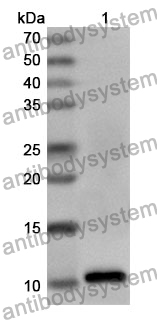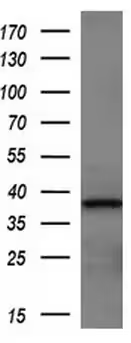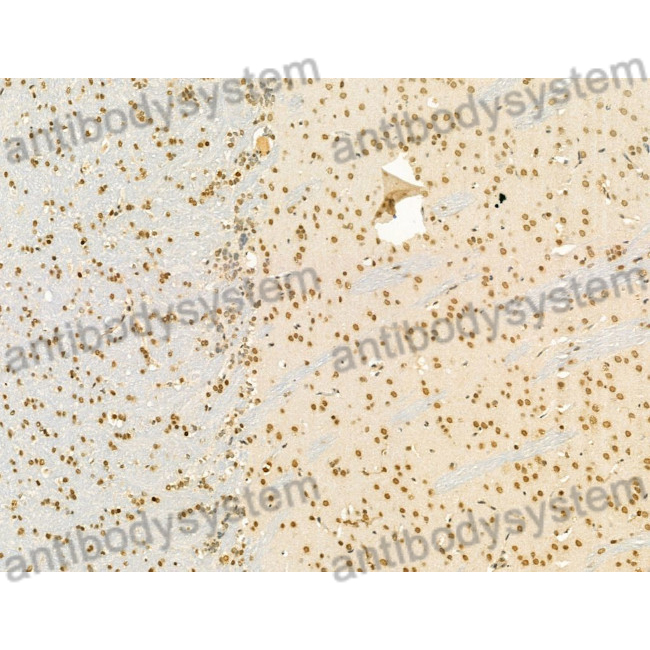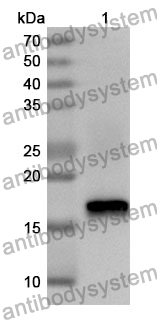Catalog No.
PHD71701
Species reactivity
Human
Host species
Rabbit
Isotype
IgG
Clonality
Polyclonal
Immunogen
E. coli - derived recombinant Human ZFP36 (Thr106-Gly176).
Tested applications
ELISA: 1:4000-1:8000, IHC: 1:50-1:100, WB: 1:1000-1:4000
Target
Zinc finger protein 36, RNF162A, TIS11A, Growth factor-inducible nuclear protein NUP475, Zfp-36, ZFP36, G0/G1 switch regulatory protein 24, G0S24, Tristetraprolin, NUP475, mRNA decay activator protein ZFP36, TTP
Purification
Purified by antigen affinity column.
Accession
P26651
Applications
ELISA, IHC, WB
Form
Liquid
Storage buffer
0.01M PBS, pH 7.4, 50% Glycerol, 0.05% Proclin 300.
Stability and Storage
Use a manual defrost freezer and avoid repeated freeze thaw cycles. Store at 2 to 8°C for frequent use. Store at -20 to -80°C for twelve months from the date of receipt.
ZFP36-family RNA-binding proteins in regulatory T cells reinforce immune homeostasis., PMID:40328742
Senescence-induced p21high macrophages contributed to CD8+ T cells-related immune hyporesponsiveness in kidney transplantation via Zfp36/IL-27 axis., PMID:40234384
Copy number variation and clinical response to chemotherapy and bevacizumab in the Czech metastatic colorectal cancer patients., PMID:39174331
The RNA binding proteins ZFP36L1 and ZFP36L2 are dysregulated in airway epithelium in human and a murine model of asthma., PMID:37928904
Tristetraprolin overexpression drives hematopoietic changes in young and middle-aged mice generating dominant mitigating effects on induced inflammation in murine models., PMID:37535204
RNA Sequencing Reveals Beneficial Effects of Atorvastatin on Endothelial Cells in Acute Kawasaki Disease., PMID:35861833
Cisplatin resistance of NSCLC cells involves upregulation of visfatin through activation of its transcription and stabilization of mRNA., PMID:34656559
Regulated Tristetraprolin Overexpression Dampens the Development and Pathogenesis of Experimental Autoimmune Uveitis., PMID:33569048
Tristetraprolin Regulates TH17 Cell Function and Ameliorates DSS-Induced Colitis in Mice., PMID:32922402
Dynamics of peripheral T cell clones during PD-1 blockade in non-small cell lung cancer., PMID:32591861
Maintenance of the marginal-zone B cell compartment specifically requires the RNA-binding protein ZFP36L1., PMID:28394372
RNA-binding proteins ZFP36L1 and ZFP36L2 promote cell quiescence., PMID:27102483
Enhanced stability of tristetraprolin mRNA protects mice against immune-mediated inflammatory pathologies., PMID:26831084
Sustained interleukin-1β exposure modulates multiple steps in glucocorticoid receptor signaling, promoting split-resistance to the transactivation of prominent anti-inflammatory genes by glucocorticoids., PMID:25977599
Differential expression and functional analysis of the tristetraprolin family during early differentiation of 3T3-L1 preadipocytes., PMID:22701344
A synonymous polymorphism of the Tristetraprolin (TTP) gene, an AU-rich mRNA-binding protein, affects translation efficiency and response to Herceptin treatment in breast cancer patients., PMID:21875902
Constitutive ERK activity induces downregulation of tristetraprolin, a major protein controlling interleukin8/CXCL8 mRNA stability in melanoma cells., PMID:21593445
Involvement of Tis11b, an AU-rich binding protein, in induction of apoptosis by rituximab in B cell chronic lymphocytic leukemia cells., PMID:19092855
Production and characterization of ZFP36L1 antiserum against recombinant protein from Escherichia coli., PMID:18302406
Inhibition of TGF-beta signaling by IL-15: a new role for IL-15 in the loss of immune homeostasis in celiac disease., PMID:17324400
Expression, purification, and biochemical characterization of the antiinflammatory tristetraprolin: a zinc-dependent mRNA binding protein affected by posttranslational modifications., PMID:15504035
[Analysis of the kinetic of expression of tristetraprolin and HuR by rheumatoid arthritis patients peripheral blood mononuclear cells stimulated with lipopolysaccharide]., PMID:15309217
Herpes simplex virus 1 induces cytoplasmic accumulation of TIA-1/TIAR and both synthesis and cytoplasmic accumulation of tristetraprolin, two cellular proteins that bind and destabilize AU-rich RNAs., PMID:15280467
Expression of tristetraprolin (G0S24) mRNA, a regulator of tumor necrosis factor-alpha production, in synovial tissues of patients with rheumatoid arthritis., PMID:15170914
Regulation and localization of endogenous human tristetraprolin., PMID:12823857
Analysis of the function, expression, and subcellular distribution of human tristetraprolin., PMID:12115244
Members of the tristetraprolin family of tandem CCCH zinc finger proteins exhibit CRM1-dependent nucleocytoplasmic shuttling., PMID:11796723
HuA and tristetraprolin are induced following T cell activation and display distinct but overlapping RNA binding specificities., PMID:11602610
Roles of tumor necrosis factor-alpha receptor subtypes in the pathogenesis of the tristetraprolin-deficiency syndrome., PMID:11588035
Bone marrow transplantation reproduces the tristetraprolin-deficiency syndrome in recombination activating gene-2 (-/-) mice. Evidence that monocyte/macrophage progenitors may be responsible for TNFalpha overproduction., PMID:9276715
A pathogenetic role for TNF alpha in the syndrome of cachexia, arthritis, and autoimmunity resulting from tristetraprolin (TTP) deficiency., PMID:8630730
Schizosaccharomyces pombe zfs1+ encoding a zinc-finger protein functions in the mating pheromone recognition pathway., PMID:8534915
Protein kinase C isozyme distribution and down-regulation in relation to insulin-stimulated c-fos induction., PMID:8063739




